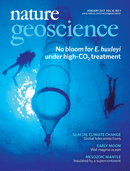Advertisement |
 |
|
 |
 |
TABLE OF CONTENTS
|
January 2017 Volume 10, Issue 1 |
 |  |  |
 |  Editorial Editorial
 News and Views News and Views
 Articles Articles
| |
 |
|
 |
 |
| Advertisement |
 |
npj Clean Water: open for submissions
An open access, online-only journal, dedicated to publishing high-quality papers that describe the significant and cutting-edge research that continues to ensure the supply of clean water to populations.
Explore the benefits of submitting your next manuscript. |  | |
 |
| |
Editorial |  Top Top |
 |
 |
 |
More space for space p1
doi:10.1038/ngeo2874
Born from astronomy, the study of planets is becoming increasingly geoscience. As divisions between disciplines continue to blur in Solar System studies, at Nature Geoscience we are looking forward to exciting joint projects with Nature Astronomy.
|
 |
News and Views |  Top Top |
 |
 |
 |
|
 |
Articles |  Top Top |
 |
 |
 |
Silicate mineralogy at the surface of Mercury pp9 - 13
Olivier Namur & Bernard Charlier
doi:10.1038/ngeo2860
The MESSENGER spacecraft has revealed geochemical diversity across Mercury's surface. Magma crystallization experiments suggest a crustal mineralogy consistent with a transition towards shallower and cooler mantle melting conditions.
|
 |
Evidence for an early wet Moon from experimental crystallization of the lunar magma ocean pp14 - 18
Yanhao Lin, Elodie J. Tronche, Edgar S. Steenstra & Wim van Westrenen
doi:10.1038/ngeo2845
The Moon is thought to have initially had a magma ocean that gradually solidified. Crystallization experiments find that the resulting crustal thickness depends on water content and is consistent with significant water in the early Moon.
|
 |
Competitive fitness of a predominant pelagic calcifier impaired by ocean acidification pp19 - 23
Ulf Riebesell, Lennart T. Bach, Richard G. J. Bellerby, J. Rafael Bermúdez Monsalve, Tim Boxhammer et al.
doi:10.1038/ngeo2854
Ocean acidification can affect growth and calcification rates of calcifying phytoplankton. Mesocosm experiments reveal that acidification can also cause declines in population size and inhibit bloom formation.
|
 |
N2 production rates limited by nitrite availability in the Bay of Bengal oxygen minimum zone pp24 - 29
L. A. Bristow, C. M. Callbeck, M. Larsen, M. A. Altabet, J. Dekaezemacker et al.
doi:10.1038/ngeo2847
Nitrogen losses have not been observed in the Bay of Bengal, unlike in other ocean oxygen minimum zones. Chemical and molecular analyses reveal that trace levels of oxygen inhibit nitrate formation, largely preventing microbial N2 production.
|
 |
Metabolism in anoxic permeable sediments is dominated by eukaryotic dark fermentation pp30 - 35
Michael F. Bourke, Philip J. Marriott, Ronnie N. Glud, Harald Hasler-Sheetal, Manoj Kamalanathan et al.
doi:10.1038/ngeo2843
Bacteria have been assumed to dominate organic matter decomposition in marine sediments. In flow-through reactor experiments, algae were revealed to be primarily responsible for anaerobically metabolizing organic matter in permeable sediments.
See also: News and Views by Rao |
 |
Global atmospheric teleconnections during Dansgaard–Oeschger events pp36 - 40
Bradley R. Markle, Eric J. Steig, Christo Buizert, Spruce W. Schoenemann, Cecilia M. Bitz et al.
doi:10.1038/ngeo2848
Abrupt glacial climate changes were slowly communicated between hemispheres by oceanic heat transport. Ice core data point to more rapid atmospheric teleconnections linking the North Atlantic, tropics, and southern storm track.
See also: News and Views by Abram |
 |
Constraints on ocean carbonate chemistry and pCO2 in the Archaean and Palaeoproterozoic pp41 - 45
C. L. Blättler, L. R. Kump, W. W. Fischer, G. Paris, J. J. Kasbohm et al.
doi:10.1038/ngeo2844
The composition of the oceans on early Earth has been challenging to assess. Calcium isotope records from carbonate rocks formed 1.9 to 2.7 billion years ago rule out high alkalinity, and are consistent with moderate to high CO2 concentrations.
|
 |
Metamorphic record of catastrophic pressure drops in subduction zones pp46 - 50
P. Yamato & J. P. Brun
doi:10.1038/ngeo2852
Rocks are altered by high pressure during subduction. Analysis of exhumed metamorphic rocks suggests that the peak pressures recorded within minerals mark a change in tectonic regime within a subduction zone, rather than burial depth.
|
 |
Subduction megathrust creep governed by pressure solution and frictional–viscous flow pp51 - 57
Åke Fagereng & Sabine A. M. den Hartog
doi:10.1038/ngeo2857
The controls on fast versus slow fault slip in subduction zones are unclear. Rock deformation experiments suggest that faults within the seismogenic region of a subduction zone may slip aseismically due to pressure solution creep.
|
 |
Decrease in oceanic crustal thickness since the breakup of Pangaea pp58 - 61
Harm J. A. Van Avendonk, Joshua K. Davis, Jennifer L. Harding & Lawrence A. Lawver
doi:10.1038/ngeo2849
Thicker oceanic crust forms from a hot mantle. Observations of unusually thick oceanic crust that formed 170 million years ago in the Atlantic and Indian oceans suggest that the ancient supercontinent Pangaea helped insulate and warm the mantle.
See also: News and Views by Lenardic |
 |
An accelerating high-latitude jet in Earth's core pp62 - 68
Philip W. Livermore, Rainer Hollerbach & Christopher C. Finlay
doi:10.1038/ngeo2859
Satellite observations have detected localized magnetic field changes at high latitudes. Simulations suggest these changes can be explained by a westward jet in the liquid core, which has been accelerating over the past 15 years.
|
 |
 Top Top |
 |
 |
 |  |  |  |  |  | Natureevents is a fully searchable, multi-disciplinary database designed to maximise exposure for events organisers. The contents of the Natureevents Directory are now live. The digital version is available here.
Find the latest scientific conferences, courses, meetings and symposia on natureevents.com. For event advertising opportunities across the Nature Publishing Group portfolio please contact natureevents@nature.com |  |  |  |  |  |
|
 |


No comments:
Post a Comment